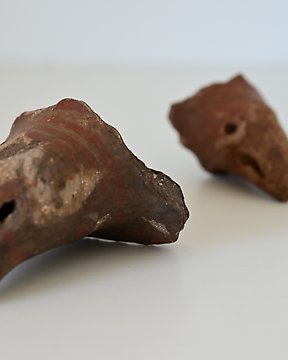
Precolumbiaans Terracotta Adelaarskoppen. Spaanse exportvergunning. - 8 cm
Nr. 84052779

Nr. 84052779

Ameca-Ezatlan Style, Jalisco, Mexico, 300 BC to 200 AD.
Height: 21 cm.
-Provenance:
Ex. Collection Mr. H.K. Amsterdam
Note: Property from Very Important Dutch Private Collection!
The collection consists of ca. 14 Chinese pottery objects (including horses form the Six dynasties to Tang dynasty, attendants, musicians, guards of honor, camels), ca. 25 Pre-Columbian, and 10 Egyptian objects, all objects will be auctioned in the coming Catawiki auctions.
- from the H. K. collections.
Mr. H. K. was one of the Dutch foremost art collectors, the range of whose interests was extraordinary. These included Chinese, Egyptian, Pre-Columbian, and South-East Asian art.
Mr. K. was chairman of the ABU from 1999 to 2014. In addition, K. was chairman of Youth Care Netherlands, member of the Social-Economic Council (SER), columnist for “Het Financieele Dagblad”, active at VNO-NCW, advisor to the presidium of the House of Representatives, he held many supervisory positions and was active at FNV. He was consistently one of the 200 most influential people in the Netherlands, according to de Volkskrant!
Note: It will be professionally packed and safely sent within 3 working days by FedEx. Shipped with Insurance!
The current piece falls within the style known as the Ameca-Ezatlán group, which is characterised by elongated faces, turban-like headwear, wide mouths, large hands, defined nails and staring eyes with elevated rims. The current piece is therefore a classic example of the tradition. Insofar as theme is concerned, the subject matter is likewise traditional. Just as in other sophisticated social systems around the world – such as the Egyptians or Dynastic China – figures were made to represent the sorts of people and resources that might be needed in the hereafter. They were in this sense symbolic of actual people, who were buried with the deceased as retainers in more sanguineous Central and Southern American societies. Seemingly supernatural figures are also known, presumably representing aspects of Jalisco cultural heritage (gods, spirits, ancestors, mythological figures etc) that are currently beyond our understanding, while maternity figures are also fairly well-known. Of all the groups, however, it is perhaps the warriors that are the most dramatic.
Additional Information:
There are many distinct groups within the agglomeration referred to as the Western Mexico Shaft Tomb (WMST) tradition, foremost among them the Jalisco, Nayarit, and Colima. Their relationships are almost totally obscure due to the lack of contextual information. However, it is the artworks that are the most informative. All of the cultures encompassed under the WMST umbrella were in the habit of burying their dead in socially-stratified burial chambers at the base of deep shafts, which were in turn often topped by buildings. Originally believed to be influenced by the Tarascan people, who were contemporaries of the Aztecs, thermoluminescence has pushed back the dates of these groups over 1000 years.
Although the apogee of this tradition was reached in the last centuries of the 1st millennium BC, it has its origins over 1000 years earlier at sites such as Huitzilapa and Teuchitlan, in the Jalisco region. Little is known of the cultures themselves, although preliminary data seems to suggest that they were sedentary agriculturists with social systems not dissimilar to chiefdoms. These cultures are especially interesting to students of Mesoamerican history as they seem to have been to a large extent outside the ebb and flow of more aggressive cultures – such as the Toltecs, Olmecs and Maya – in the same vicinity. Thus insulated from the perils of urbanization, they developed very much in isolation, and it behooves us to learn what we can from what they have left behind.
There are few cultures in the Americas or indeed elsewhere that can match the Jalisco for exuberant skill in the production of figurative ceramics. These wares were usually placed in graves, and do not seem to have performed any practical function, although highly decorated utilitarian vessels are also known. It is possible that they were designed to depict the deceased – they are often very naturalistic – although it is more probable that they constituted, when in groups, a retinue of companions, protectors and servants for the hereafter. Many of the figures represent warriors, judging from their apparel and martial stance. These were probably protectors of the deceased, symbolic of actual people who were buried with the deceased as retainers in more sanguineous Central and Southern American societies. Supernatural and more enigmatic figures are also known, presumably representing aspects of Jalisco cultural heritage (gods, spirits, ancestors, mythological figures etc) that cannot be understood at the present time. However, perhaps the best-known style is that of the maternity figure.
Condition: good condition for its age. Wear consistent with the age, some loss of color cracks, and restorations.
Important information.
The seller guarantees that he is entitled to ship this lot.
It will be professionally packed and safely sent by FedEx.
Buyers are responsible for import regulation and restrictions of their own country.
Catawiki disclaimer: This piece has been dated based on style by the seller . No further tests, such as, a TL test, analysis of pigments or radiography scans have been conducted to check the integrity of the piece.
Zo koop je op Catawiki
1. Ontdek iets bijzonders
2. Plaats het hoogste bod
3. Veilig betalen